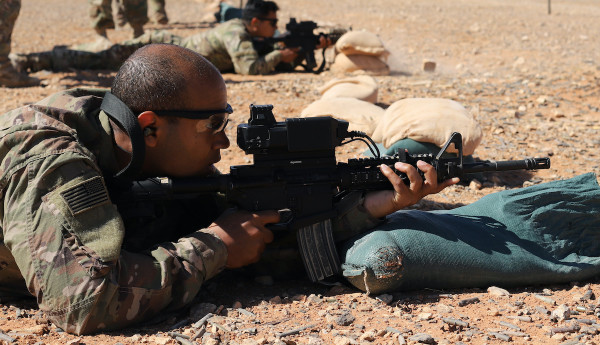

U.S. special operations forces are currently testing and evaluating a specially-designed computerized fire control and rifle sight system downrange in Syria, U.S. Special Operations Command confirmed to Task & Purpose.
Photos published to the Defense Visual Information Distribution Service (DVIDS) on May 30, first reported by The War Zone, show several unidentified U.S. service members at the At Tanf garrison in Syria engaging targets with M4 carbines outfitted with a SMASH 2000 system.
The SMASH 2000, developed by Israeli defense contractor Smart Shooter in cooperation with Sig Sauer, uses a weapon-mounted optic and special pistol grip that “allows you to acquire, lock on and engage targets … [and] the weapon to fire only when it’s a guaranteed hit,” company CEO Devin Schweiss previously told Military.com
In the photos, “coalition forces” are pictured “zero[ing] Smart Shooter sighting devices during a familiarization range,” according to a caption: “Coalition and partner forces regularly train on various weapon systems in a joint effort to help set conditions for the enduring defeat of Daesh in Syria.”
As The War Zone points out, the SOF personnel pictured in the DVIDS photos appear to be practicing on a target suspended from a small personal drone as part of training on tracking and engaging the unmanned aerial systems that have plagued U.S. forces in Syria in recent months.
“We are evaluating the Smart Shooter system as a potential individual-level solution to enhancing Special Operations Forces capabilities for countering unmanned aerial systems,” SOCOM spokesman Lt. Cmdr. Tim Hawkins confirmed to Task & Purpose in an email.

Here’s how the SMASH 2000 system works, as Schweiss previously described to Military.com:
The SMASH features a lock button that’s mounted on the weapon’s handguard. The shooter looks through the SMASH optic, places the crosshairs on the target and presses the button to mark the target with a tiny rectangle.
As the information is fed back into the computer, the shooter keeps the crosshairs on the target and pulls the trigger, but the weapon will not fire unless the sights are lined up properly. If the target moves suddenly, the shooter continues to keep the crosshairs on the target. When the shot is lined up, the SMASH will fire the weapon, Schweiss said.
“While I am holding down this button, I am acquiring targets through image processing. … Once I release it, it will lock the target and give me and aimpoint,” he said. “Then I just hold down the trigger, align my crosshairs to where the system tells me to, and the system will fire whenever it’s a hit.”
According to Hawkins, the command purchased the SMASH 2000 systems from Smart Shooter in March 2019 to evaluate the capability in an operational environment.
SOCOM currently has 98 of the SMASH 2000 systems in its inventory, Hawkins said. The results of the evaluation, conducted by the command’s Army and Navy service components and Special Operations Command Central (SOCCENT) personnel, are currently pending.
SOCOM isn’t the only command interested in the Smart Shooter systems: According to Smart Shooter CEO Schweiss, the Army is currently evaluating the SMASH 2000 as part of its search for an advanced fire control system to go with the service’s Next-Generation Squad Weapon.

The focus on countering unmanned aerial systems in Syria is of increasing importance to the U.S. military. Indeed, U.S. Central Command chief Marine Gen. Kenneth McKenzie affirmed during congressional testimony in March that personnel deployed to Syria had in recent months come under attack from drones laden with explosives that were “possibly” operated by ISIS fighters in the region.
“The Russians have had some significant casualties in this regard, as have other nations that are operating there,” McKenzie told lawmakers at the time. “So yes, it is a problem. We look at it very hard. It’s one of my highest priorities.”
According to Business Insider, counter-drone systems were also a major part of in CENTCOM’s 2020 unfunded priorities list, which contains funding requests not included in the command’s fiscal year budget request submitted to Congress.
Hostile drones “have expanded in size, sophistication, range, lethality and numbers” and are being used throughout CENTCOM’s area of responsibility, McKenzie wrote, noting that “low velocity and altitude makes them difficult to detect on radar and limited options exist in effectively defeating them.”
The unfunded priorities list requested $67.6 million for systems to “help counter these airborne IEDs and intelligence gatherers,” Business Insider reported.
“We’re open to anything, and a lot of smart people are looking at this,” McKenzie said in March. “This is a significant threat.”
